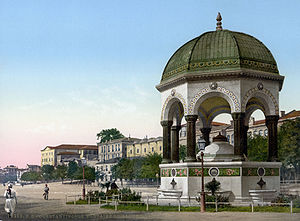Istanbul
From Kaiserreich
Istanbul(Constantinople, Konstantiniyye) is the capital of the Ottoman Empire
 Istanbul in 1870, as seen from the Galata Tower
Istanbul in 1870, as seen from the Galata Tower
History
The first human settlement in Istanbul, is from the Copper Age period, with artifacts dating from 5500–3500 BC. Cape Moda in Chalcedon was the first location which the Greek settlers of Megara chose to colonize in 685 BC, prior to colonizing Byzantion on the European side of the Bosphorus under the command of King Byzas in 667 BC.
The location of Byzantium attracted Constantine I in 324 after a prophetic dream was said to have identified the location of the city.Byzantium (now renamed as Nova Roma which eventually became Constantinopolis, i.e. "The City of Constantine") was officially proclaimed the new capital of the Roman Empire six years later, in 330. Following the death of Theodosius I in 395 and the permanent partition of the Roman Empire between his two sons, Constantinople became the capital of the Eastern Roman (Byzantine) Empire. As well as being the centre of an imperial dynasty, the unique position of Constantinople at the centre of two continents made the city a magnet for international commerce, culture and diplomacy. The Byzantine Empire was distinctly Greek in culture and became the centre of Greek Orthodox Christianity, while its capital was adorned with many magnificent churches, including the Hagia Sophia, once the world's largest cathedral.
On May 29, 1453, Sultan Mehmed II "the Conqueror" captured Constantinople after a 53-day siege and proclaimed that the city was now the new capital of his Ottoman Empire. Sultan Mehmed's first duty was to rejuvenate the city economically, creating the Grand Bazaar and inviting the fleeing Orthodox and Catholic inhabitants to return. The Sultan also endowed the city with various architectural monuments, including the Topkapı Palace and the Eyüp Sultan Mosque. Religious foundations were established to fund the construction of grand imperial mosques (such as the Fatih Mosque which was built on the spot where the Church of the Holy Apostles once stood), adjoined by their associated schools, hospitals and public baths. Suleiman the Magnificent's reign of the Ottoman Empire from 1520 to 1566 was a period of great artistic and architectural achievements. The famous architect Sinan designed many mosques and other grand buildings in the city, while Ottoman arts of ceramics and calligraphy also flourished.

German fountain, constructed to commemorate the second anniversary of German Emperor Wilhelm II's visit to Istanbul in 1898.
